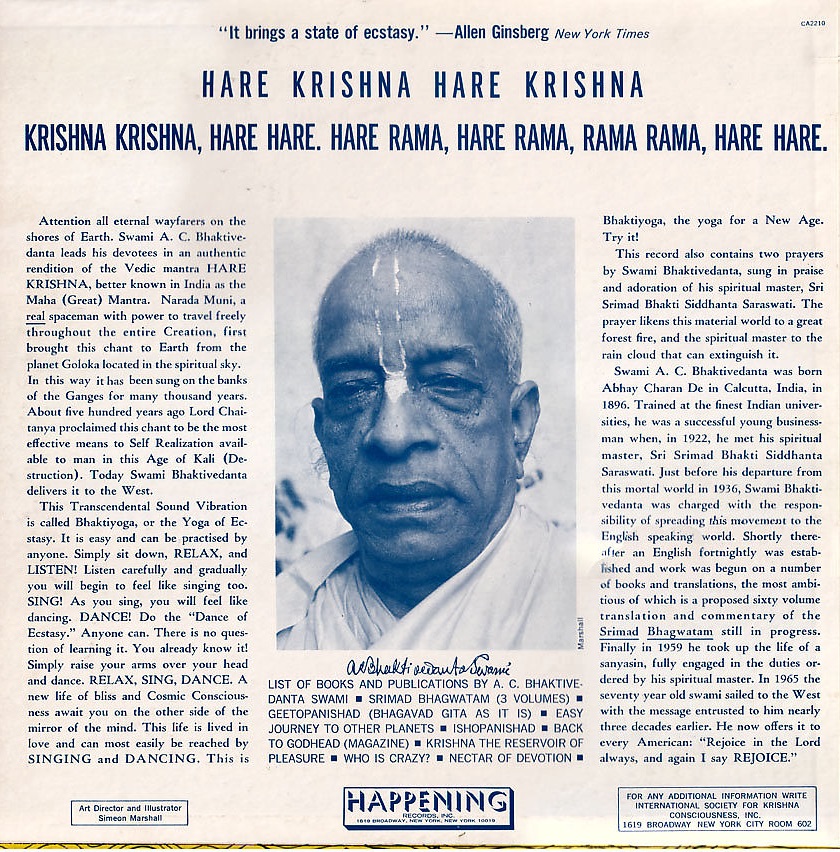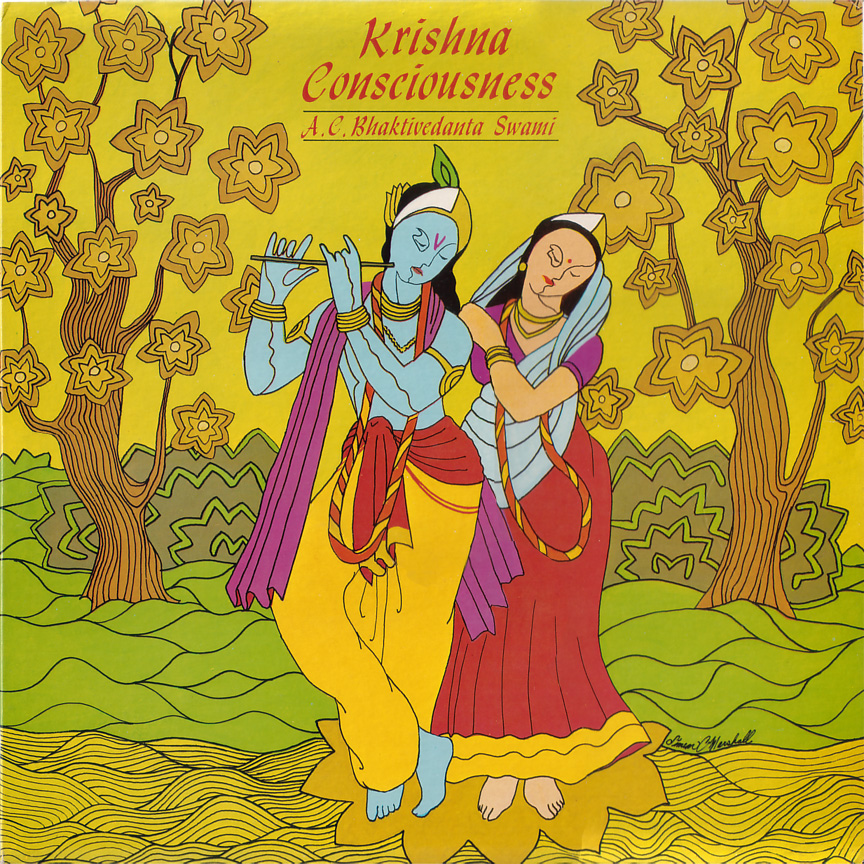The Happening Album: “Krishna Consciousness”
by Hansadutta Das on KRSNA Tunes
This is the first Hare Krishna record album, produced in 1966 by Alan Kallman in New York. Satsvarupa das Gosvami has written about it: First Hare Krsna Albums (posted at bottom). Mr. Kallman, a record producer, and his wife came to see Prabhupada at 26 Second Avenue one evening in 1966, and inspired by the joyous kirtan, suggested that Prabhupada and the devotees make a record.
Mr. Kallman returned to meet with Prabhupada and talk over the terms. When the day arrived, Prabhupada and the devotees led a boisterous chanting party around Times Square, on their way to the recording studio there, with Hayagriva playing bass drum and others playing karatals. Once inside the studio, they practiced with the sound engineer for about fifteen minutes, and then the record was cut on the first take. Prabhupada played a wooden khol, others played karatals or sticks (the sound engineer reduced the number of karatals). The Hare Krishna mantra on the first side lasted about 12 minutes. Then the second side was recorded with Prabhupada singing the Samsara prayers, accompanied by Kirtanananda on harmonium. Prabhupada also spoke the purport of the mantra. An artist at Happening Records came up with the album art. It is said that Prabhupada very much liked the photo of himself on the back of the album sleeve, that he approved of its solemn disposition. Production was delayed, but when it did come out, the record sold out quickly. Apparently the Beatles also got hold of a copy of the record and liked it.
First Hare Krishna Albums
by Satsvarupa das Goswami
This is the cover of the first long-playing record made by the Hare Krishna movement. A man named Alan Kallman and his wife came to an evening kirtana at 26 Second Avenue in 1966, and he was impressed with the kirtana. He was a producer of records, and he thought the kirtana had the potential for a selling record. He went to see Swamiji to talk about it. Prabhupada talked over the financial conditions of how much we would get for it, and he was satisfied. I forget the terms of the contract, but we would buy the record at a low price and sell it ourselves. The recording evening was a wonderful event. About a dozen of us went with Prabhupada to a studio around 42nd St. and Times Square. Before we went into the studio, we had a marching harinama around Times Square, with Hayagriva playing our big bass drum and some of us playing karatalas. In the studio a rock band just finished playing, and as the young men came out they asked us what was the name of our group. Hayagriva said we were the “Hare Krishna Chanters.” We practiced chanting with the studio engineer. He thought we had too many karatalas, and he reduced them and gave us some sticks to play. Prabhupada played a big wooden khol which a friend of the movement had lent him. After about fifteen minutes of practice, we cut the record just one time through. Prabhupada led with a few prayers and then led the Hare Krishna mantra, and we joined in chorus. It was a thrill singing with him in those conditions. The Hare Krishna mantra lasted about 12 minutes, and then they stopped it. Then they recorded a second side of the record. Prabhupada sang by himself Samsara-dava-nala-lidha-loka (Guruvastakam), with Kirtanananda playing the harmonium as a drone. He also spoke an introduction to the mantra. The engineers played the recording out loud in the studio. We were so happy, we all got up and danced to the music.
The artwork was done by an artist at “Happening Records.” It had a nice photo of Prabhupada on the back. He liked it and said, “A swami should look philosophical.” There was a long delay in Mr. Kallman producing the record, which strained his relationship with Prabhupada, but when it finally came out it was worth it. We sold all the records, and many people got to hear the Hare Krishna mantra. The Beatles got a copy and liked it very much. It was our last commercial record, and a disciple named Dinesh produced the second LP, Vande ’Ham, with a sitar player from the Ali Akbar School of Music. That record featured Srila Prabhupada singing “The Prayer of the Six Goswamis,” but nothing ever matched going to Times Square with Srila Prabhupada and recording the first Hare Krishna album. The swami’s voice was strong, and his khol-playing was expert. Our chorus was pretty good too. Ravindra Svarupa heard the recording at a friends and thought it was a “timeless experience.”

